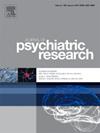The effect of bilateral high-definition γ-tACS on negative symptoms and mismatch negativity in schizophrenia
IF 3.2
2区 医学
Q1 PSYCHIATRY
引用次数: 0
Abstract
Background
At present, there is a lack of good treatment methods for the negative symptoms of schizophrenia. Previous studies have suggested that high-definition transcranial alternating current stimulation (HD tACS) in the dorsolateral prefrontal cortex (DLPFC) can significantly improve negative symptoms and that γ oscillation may also be effective for treating negative symptoms. The aim of our study was to investigate the therapeutic effect of HD γ-tACS on the negative symptoms of schizophrenia. Active auditory mismatch negativity (MMN) was introduced as neurobiological evidence to verify the intervention effect of tACS on schizophrenia.
Methods
A total of 53 patients with schizophrenia mainly with negative symptoms were enrolled in our study. Twenty-seven patients were divided into a real group, which was based on 60 Hz stimulation, 15 min on the unilateral side, for 10 consecutive working days, and 26 patients were divided into a sham group to receive tACS intervention. At baseline and after the intervention, the clinical and behavior scale measurements and EEG data collection under the active auditory oddball paradigm were performed in the two groups, and the differences between the two groups were compared and analysed.
Results
1. At baseline, there was no significant difference in the active MMN (MMN/P3a complex) amplitude between the two groups. 2. After tACS intervention, the active MMN amplitudes of the Fz, FCz, Cz, CPz and Pz channels in the central frontoparietal lobe of the real tACS group increased significantly. 3. Negative symptoms were significantly reduced in the real tACS group positive and negative syndrome scale (PANSS) negative symptom subscale score. 4. Regression analysis revealed that in the Fz channel, the change in MMN was moderately positively correlated with the reduction in negative symptom scores.
Conclusion
γ-tACS in the bilateral dlPFC can significantly improve the negative symptoms of patients with schizophrenia, and the amplitude of active MMN in the frontoparietal region is significantly increased after intervention. To some extent, the greater the improvement in active MMN after intervention compared with baseline, the more obvious the improvement in clinical negative symptoms. This study provides a reference for tACS therapy to improve negative symptoms in patients with schizophrenia.
双侧高清晰度γ-tACS对精神分裂症患者阴性症状和错配阴性的影响
背景目前,精神分裂症阴性症状缺乏良好的治疗方法。以往的研究表明,背外侧前额叶皮质(DLPFC)的高分辨率经颅交流电刺激(HD tACS)可以显著改善阴性症状,γ振荡也可能对治疗阴性症状有效。本研究旨在探讨HD γ-tACS对精神分裂症阴性症状的治疗效果。引入主动听觉错配负性(MMN)作为神经生物学证据,验证tACS对精神分裂症的干预作用。方法对53例以阴性症状为主的精神分裂症患者进行研究。将27例患者分为真实组,以60 Hz刺激为基础,单侧刺激15分钟,连续10个工作日;将26例患者分为假组,接受tACS干预。在干预前和干预后分别对两组患者进行临床、行为量表测量和主动听怪范式下的脑电数据采集,比较分析两组差异。基线时,两组间活性MMN (MMN/P3a复合物)振幅无显著差异。2. tACS干预后,真实tACS组额顶叶中央Fz、FCz、Cz、CPz和Pz通道的MMN活性振幅显著升高。3. 阴性症状在真正的tACS组显著减少阳性和阴性症状量表(PANSS)阴性症状亚量表得分。4. 回归分析显示,在Fz通道中,MMN的变化与阴性症状评分的降低呈中度正相关。结论双侧dlPFC γ- tacs可显著改善精神分裂症患者的阴性症状,干预后额顶叶区活跃MMN振幅显著升高。在一定程度上,干预后活动性MMN较基线改善越大,临床阴性症状改善越明显。本研究为tACS治疗改善精神分裂症患者阴性症状提供参考。
本文章由计算机程序翻译,如有差异,请以英文原文为准。
求助全文
约1分钟内获得全文
求助全文
来源期刊

Journal of psychiatric research
医学-精神病学
CiteScore
7.30
自引率
2.10%
发文量
622
审稿时长
130 days
期刊介绍:
Founded in 1961 to report on the latest work in psychiatry and cognate disciplines, the Journal of Psychiatric Research is dedicated to innovative and timely studies of four important areas of research:
(1) clinical studies of all disciplines relating to psychiatric illness, as well as normal human behaviour, including biochemical, physiological, genetic, environmental, social, psychological and epidemiological factors;
(2) basic studies pertaining to psychiatry in such fields as neuropsychopharmacology, neuroendocrinology, electrophysiology, genetics, experimental psychology and epidemiology;
(3) the growing application of clinical laboratory techniques in psychiatry, including imagery and spectroscopy of the brain, molecular biology and computer sciences;
 求助内容:
求助内容: 应助结果提醒方式:
应助结果提醒方式:


